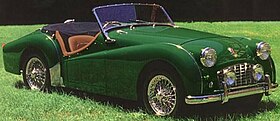Triumph TR3
| Triumph TR3 | |
|---|---|

1955–1957 Triumph TR3
|
|
| Overview | |
| Manufacturer | Standard Motor Company |
| Production | 1955–1962 |
| Assembly |
Coventry, England Melbourne, Australia Liege, Belgium Mechelen, Belgium South Africa |
| Body and chassis | |
| Class | Sports car |
| Layout | FR layout |
| Powertrain | |
| Engine | 1991 cc straight-4 2138 cc straight-4 |
| Transmission | 4-speed overdrive manual |
| Dimensions | |
| Wheelbase | 88 in (2,235 mm) |
| Length | 151 in (3,835 mm) |
| Width | 56 in (1,422 mm) |
| Height | 50 in (1,270 mm) |
| Kerb weight | 955 kg (2,105 lb) |
| Chronology | |
| Predecessor | Triumph TR2 |
| Successor | Triumph TR4 |
The Triumph TR3 is a British sports car produced between 1955 and 1962 by the Standard-Triumph Motor Company of Coventry, England. A traditional roadster, the TR3 is an evolution of the company’s earlier TR2 model, with greater power and improved braking. Updated variants, popularly but unofficially known as the "TR3A" and "TR3B", entered production in 1957 and 1962 respectively. The TR3 was succeeded by the Michelotti-styled, mechanically similar Triumph TR4.
The rugged ‘sidescreen’ TR, so named for its employment of removable plexiglass side curtains, was a sales and motorsport success. With approximately 74,800 TR3s sold across all variants, the model was the company’s third best seller, behind the TR7 (111,500 units) and TR6 (94,500 units) models. The Triumph was campaigned in races, hill climbs, and rallies across Europe and North America, with several outright, team, and class victories to its credit.
Although the car was usually supplied as an open two-seater, an occasional rear seat and bolt-on steel hard top were available as extras.
The car is powered by a 1991 cc straight-four OHV engine initially producing 95 bhp (71 kW; 96 PS), an increase of 5 hp over the TR2 thanks to the larger SU-H6 carburettors fitted. This was later increased to 100 bhp at 5000 rpm by the addition of a "high port" cylinder head and enlarged manifold. The four-speed manual gearbox could be supplemented by an overdrive unit on the top three ratios, electrically operated and controlled by a switch on the dashboard. In 1956 the front brakes were changed from drums to discs, the TR3 thus becoming the first British series production car to be so fitted.
The suspension is by double A-arms, manganese bronze trunnion, coil springs and tube shocks at the front, optional anti-roll bar, and with worm and peg steering. Unlike MGs of the same period, the steering mechanism and linkage have considerable play and friction, which increase with wear.
...
Wikipedia
